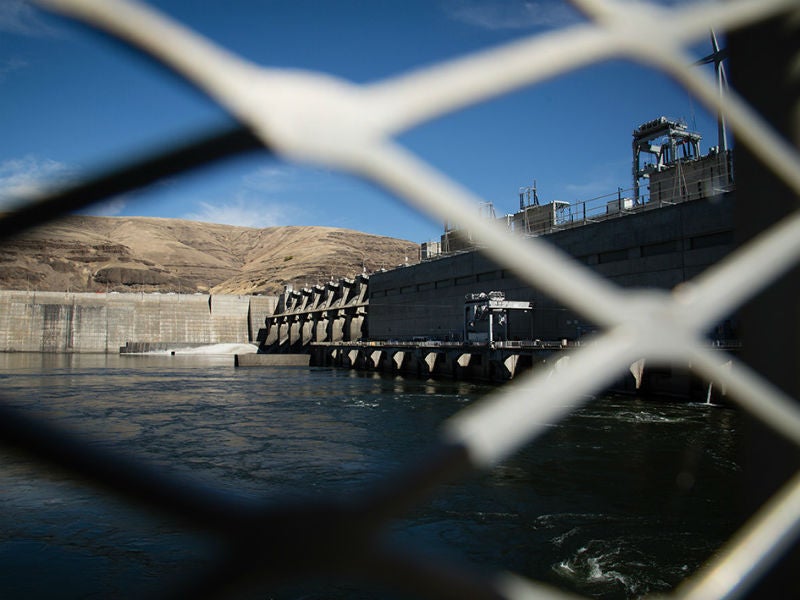A Swim in the Right Direction for Snake River Salmon
Increasing the flow of water over Columbia-Snake River dams will provide salmon with a measure of protection until officials decide whether to remove four dams on the lower Snake River completely.

This page was published 8 years ago. Find the latest on Earthjustice’s work.
Update, 04/02/2018: The Ninth Circuit Court of Appeals today upheld the April 2017 decision that will force federal dam managers to increase spill over dams on the Columbia and Snake Rivers. The decision, which was appealed unsuccessfully by the National Marine Fisheries Service, will facilitate the passage of young salmon to the Pacific Ocean. The new spill operations will begin tomorrow at some dams, just in time to save the salmon beginning their springtime migration to the sea. “The measures the Court upheld will give salmon a fighting chance,” said Todd True, Earthjustice attorney on the case.
Original post, 04/06/2017: This looks to be a grim season for salmon fishermen in the Pacific Northwest, since fisheries managers have forecasted the lowest returns of steelhead in decades. However, fishermen have reason to hold out hope for future seasons.
Last week, in response to Earthjustice litigation, a federal court ordered dam operators on the Columbia and Snake Rivers to increase the flow of water over eight dams, which will help juvenile salmon survive as they migrate downstream to the Pacific Ocean. Every year, many of these salmon are born in pristine, cold-water streams in central Idaho and beyond. In order to survive and reproduce, they must embark on a perilous journey to coastal waters and back again—a trip made even more dangerous by the dams.
Because of the court’s decision, starting in 2018 federal dam operators must increase the amount of water released over spillways—structures that control how much water flows past dams. Spilling more water over the dams will hasten juvenile fish migration, leaving the fish less vulnerable to predators and to rising water temperatures caused by global warming.
Four dams on the Lower Snake River in Washington state—Ice Harbor, Lower Monumental, Little Goose and Lower Granite—are particularly harmful to salmon because they impede migration to and from the unspoiled headwaters of the Snake River, some of the best salmon habitat left in the lower 48 states. Over time, these and other dams have transformed the Columbia-Snake River system—once home to one of the greatest salmon runs in the world—into a death trap. Since the dams were completed in the 1970s, salmon populations in this area have plummeted by more than 90 percent. The four remaining species of Snake River salmon all face extinction.
The spill increase is a stopgap solution. It will offer salmon a measure of protection, but is not enough to avoid jeopardizing the future survival and recovery of these fish. The single best solution to aid endangered salmon and many other species—including imperiled southern resident orcas in Puget Sound that depend on the salmon for food—is removing the four problem dams on the Lower Snake River.
Earthjustice has fought for decades to remove these dams in order to restore salmon populations and protect local fishermen whose livelihoods depend on healthy salmon runs. In May 2016, a judge ruled that the plan to recover salmon developed by the U.S. Army Corps of Engineers, the Bonneville Power Administration and two other federal agencies overseeing dam operations in the Columbia River Basin was illegal under both the Endangered Species Act and the National Environmental Policy Act, or NEPA. The judge ordered the federal agencies to conduct an environmental impact study of the system, including the four lower Snake River dams. He further urged the agencies to consider removing these four dams as one of several alternatives in their study.
In the interim, Earthjustice—on behalf of a coalition of conservation organizations and fishing groups, with support from the state of Oregon and the Nez Perce Tribe—filed a request for an injunction to force dam operators to take some preliminary steps to save salmon. In addition to calling for increased spill over the dams, Earthjustice also sought to stop future infrastructure spending on the money-losing lower Snake River dams, in order to ensure a level playing field for all alternatives under consideration in the environmental study.
Since 2000, use of the lower Snake River to transport goods by barge has declined by more than 70 percent, while the cost to maintain the dams’ aging infrastructure has skyrocketed, costing hundreds of millions of dollars as more and more parts need to be replaced. Taxpayers lose 50 cents for every dollar they invest in maintaining the lower Snake River dams. This was one of many concerns aired by residents of the Pacific Northwest when the public had a chance to weigh in during the NEPA-mandated public comment period. In the fall of 2016, more than 250,000 people submitted remarks in support of dam removal.
The judge did not grant Earthjustice’s request for an injunction to halt ongoing spending on dam infrastructure. But he did order the government to provide us information about any future large spending projects because such spending can prejudice the consideration of alternatives in the environmental study. If the agencies keep spending millions in taxpayer dollars to extend the life of the dams, the scales could be tipped in favor of keeping them in place.
The court’s decision to increase water flows over the dams is a great short-term solution for struggling salmon, but it still falls short of what the fish need to survive. Dam removal, above all else, will produce the best possible outcome for wild salmon and the human communities that depend on them.
Established in 1987, Earthjustice's Northwest Regional Office has been at the forefront of many of the most significant legal decisions safeguarding the Pacific Northwest’s imperiled species, ancient forests, and waterways.